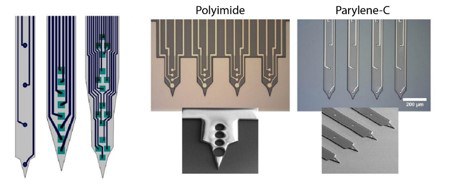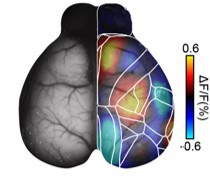Long-term electrophysiological recordings
To create a stable interface between the brain and the neuroelectronic device, the ability to record neural activity from living neural tissue over long time-scales (months to years) is crucial. To achieve this goal, we have created flexible neural recording arrays to minimize tissue damage and foreign-body reactions in the brain. These arrays are highly miniaturized, so that we can test and improve-on their long-term recording capabilities by chronically implanting them in mice. These in-vivo recordings provide critical insights into how the quality of neural recordings changes over longer time scales and which modifications can improve the stability of the neuroelectronic interface. In addition, we use the neural data from our chronic recordings to study how neural network function changes during aging and when learning new abilities.
Long-term optical recordings
Another way to chronically observe neural activity is functional imaging. Here, we use fluorescent proteins that are genetically expressed in the neural tissue to signal changes in neural activity by emitting fluorescent light. These fluorescent signals can be measured non-invasively (using microscopes, cameras or glass-fiber based photodetectors) to obtain a stable read-out of neural activity over long time scales. Depending on the imaging methods, such neural measurements are performed over a wide range of spatial scales, from tracking single-cell activity, over small neural networks or the entire cortical surface of the brain. Our studies may reveal new potential approaches for opto-electronic neural interfaces that could be employed for chronic applications in humans. Another important implication is the ability to study the function and interaction of large neural circuits in the living brain to gain new insights into the stability of neural information processing over long time scales
Dr. Simon Musall
Tel.: +49-2461-61-3539
e-mail: s.musall@fz-juelich.de
PUBLICATIONS:
"Chronic, cortex-wide imaging of specific cell populations during behavior", Couto J, Musall S et al. , Nature Protocols, 16, pages 3241–3263, June 2021.


